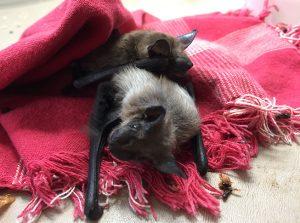What To Do If You Found Sick or Injured Baby Bat
About Baby Bats

Caution: Rabies vector species. Always wear gloves when handling.
Unnecessarily removing an animal from its environment – particularly a baby – can cause more harm than simply leaving it be. It is important to recognize signs of distress.
There are a few cases where you might need to intervene:
- The bat pup is on the ground and its eyes are closed.
- The bat pup is cold or surrounded by flies.
- The bat pup is pink and has no fur.
- A female bat is on the ground with her pups attached to her.
- The bat pup is injured or has been attacked.
- For further assistance on where and how to transport, please refer to the "Who to Call for Help" section on this page.
If you know of an animal who needs help, please call your local animal control officer, a licensed wildlife rehabilitator, or the Tufts Wildlife Clinic as soon as possible.
What to Do
Protect Yourself
Wear gloves. When dealing with non-carnivorous mammals, a thick pair of work gloves, a thick jacket, and other personal protection can prevent injury. All mammals can carry the rabies virus. Do not use bare hands when helping mammals. Please be careful not to get bitten, licked, or scratched by the animal as well.
Prepare a Container
Have a sturdy box or animal carrier ready to contain the animal. Garbage cans, recycling bins, and plastic containers will work in a pinch, depending on the size of the animal.
Capturing the Animal
Place a thick towel over the animal and quickly gather it inside the towel. Place the animal immediately in an appropriately-sized box with a secure lid. Make sure the box has air holes in the lid. If you are trying to capture a porcupine, do NOT use a towel. Use a board or other sturdy object to slowly herd the porcupine into the container.
If You Can’t Transport it Immediately
- Keep the animal in a warm, dark, and quiet place.
- Do not give it food or water. Feeding an animal an incorrect diet can result in injury or death. Also, a captured animal will get food and water stuck in its fur/feathers potentially leading to discomfort and hypothermia.
- If the animal is cold, keep it warm by putting one end of the container on a towel over a heating pad set on low. If you don’t have a heating pad, you can use microwaveable heat bags or a bottle filled with hot water placed inside the box.
- Do not handle it. Leave the animal alone. Remember human noise, touch and eye contact are very stressful to wild animals.
- Keep children and pets away from it.
Transport
For further assistance on where and how to transport, please refer to the "Who to Call for Help" section on this page.
During transport, keep the animal in the box or crate, keep the car quiet (radio off).